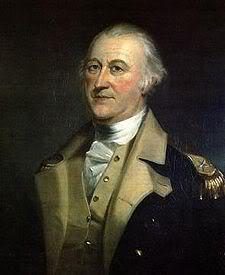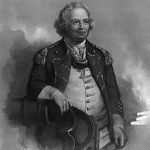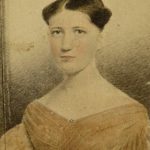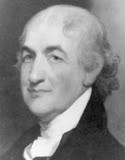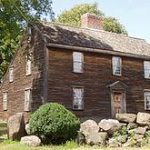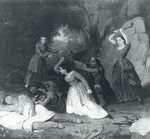Wife of Revolutionary War General Artemas Ward
Sarah Trowbridge was born on December 3, 1724, in Groton, Massachusetts, daughter of Reverend Caleb and Hannah (Walter) Trowbridge, and of direct maternal descent from Increase Mather and John Cotton.
Image: Major General Artemas Ward
Continental Army
Artemas Ward was born on November 26, 1727, at Shrewsbury, Massachusetts, to Nahum and Martha (Howe) Ward. He was the sixth of seven children. His father had broad and successful career interests as a sea captain, merchant, land developer, farmer, lawyer and judge. As a child he attended the common schools and shared a tutor with his brothers and sisters.
In 1748, at the age of 20, Ward graduated from Harvard and took a position teaching school in Groton, Massachusetts. There he met his future wife, Sarah Trowbridge, and they were married on July 31, 1750. The young couple returned to Shrewsbury where Artemas kept a farm and a busy general store. In the next fifteen years they would have eight children: Ithamar, Nahum, Sarah, Thomas, Artemas, Jr., Henry Dana, Martha and Maria.
In 1751, Ward was named a township assessor for Worcester County. This was the first of many public offices he was to fill. Artemas was elected a Justice of the Peace in 1752 and served the first of his many terms in the Massachusetts Bay Colony’s General Court in Boston.
In 1755 the militia was restructured for the French and Indian War, and Artemas Ward was made a major in the 3rd Regiment, which served as garrison forces along the frontier in western Massachusetts. In 1757 he was made the colonel of the militia of Middlesex and Worchester counties. In 1758 the regiment marched with General James Abercrombie to Fort Ticonderoga, but the difficult campaign in the Adirondacks ruined his health. He never fully regained his strength.
On Ward’s return to Shrewsbury, he was appointed colonel of his militia regiment, and in 1762, a judge of the Court of Common Pleas. For the next decade, he distinguished himself with his dogged opposition to royal authority, drawing the wrath of crown officials and the admiration of patriots.
Serving again in the General Court, Ward was placed on the taxation committee along with Samuel Adams and John Hancock. On the floor, he was second only to James Otis in speaking out against the acts of Parliament. Because of Ward’s prominence in these debates the Royal Governor Francis Bernard revoked Ward’s military commission.
In the fall of 1774, as the British occupied Boston, the Massachusetts Provincial Congress ordered each town to train a militia. In the growing sentiment favoring rebellion, the 3rd Regiment resigned en masse from British service on October 3, 1774. They then marched to Shrewsbury to inform Colonel Ward that they had unanimously elected him their leader.
Later that month the governor abolished the assembly. The towns of Massachusetts Bay Colony responded by setting up a colony-wide Committee of Safety. One of the first actions of the Committee was to name Artemas Ward as brigadier general and commander of the colony’s militia.
April 19, 1775, was a fateful date for Artemas Ward – and for the Thirteen Colonies that would become the United States. Early that morning, British regulars and Colonial militiamen exchanged gunfire at Lexington and Concord. An express rider brought word to Shrewsbury, where Ward was sick in bed with a painful gall bladder attack.
Despite his pain, the next morning General Ward rode the 35 miles to Cambridge, where thousands of militiamen had gathered on Cambridge Common. Ward faced formidable challenges. Not only was he confronting the world’s most powerful army, but he was doing so with a force of volunteers who had agreed only to turn out for a single battle. Once the British had been driven back to Boston, many militiamen wanted to return to their farms. They had not enlisted, and had little enthusiasm for camp life.
Ward had the daunting task of creating the Grand American Army, as the newspapers referred to the collection of local militia units that were preparing for war. He appealed for volunteers to become the first enlistees. Men from Massachusetts, New Hampshire, Connecticut, and Rhode Island began to fill the ranks.
Critics complained that Ward was a lax disciplinarian, but he understood that his volunteer Yankee soldiers would not tolerate, nor did he have legal authority to impose, strict discipline. He had to lead by consensus and mutual respect, for as one patriot wrote to Samuel Adams, “our soldiers will not be brought to obey any person of whom they do not themselves entertain a high opinion.” Ward’s deft management helped his raw recruits hold the siege of Boston.
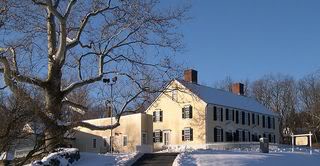
Image: Artemas Ward House
Ward’s lifelong home had been built by his father, Nahum, about the time Artemas was born. The home is now a museum preserved by Harvard University. Located at 786 Main Street in Shrewsbury, Massachusetts, it is open to the public for limited hours during the summer months. Many additions were made to the house over the years.
Additional British forces arrived in Boston in May, and in June General Ward learned of their plan to attack Bunker Hill. He gave orders to fortify the point, setting the stage for the Battle of Bunker Hill on June 17, 1775. Command during the battle devolved upon General Israel Putnam and Colonel William Prescott.
While General Ward received national recognition for the heroic stand made at Bunker Hill, his principal contribution was a failure to supply enough ammunition to hold the position. He remained at headquarters in Cambridge and had no share in determining the events of that day.
Meanwhile on June 17, 1775, the Continental Congress in Philadelphia was creating a Continental Army. They debated who should be appointed supreme commander of the American forces. John Adams reported that “the greatest number” wanted the job to go to Artemas Ward. However, an overriding concern was to persuade delegates from the South that this was not just New England’s war.
The Congress chose George Washington of Virginia commander-in-chief of the Continental Army. Artemas Ward was promoted to the rank of major general and given the command of the right wing with headquarters at Roxbury. Ward was trusted and admired by the volunteer militiamen, and over the next nine months he would help convert the assembled militia units into the Continental Army.
On July 3, 1775, George Washington arrived in Cambridge, and immediately began criticizing Ward publicly and in writing. Accustomed to serving with professional officers, Washington was appalled by the lax discipline among the New England soldiers. Ward was deeply offended, and relations between the two men never improved.
After the British evacuation of Boston, Washington led the main army to New York City. For the next five years, the main bodies of the Continental and British armies campaigned against one another in New York, New Jersey, and Pennsylvania. Ward took command of the Eastern Department with headquarters in Boston, remaining in that post until March 20, 1777, on the repeated requests of the Continental Congress and Washington, despite serious ill health.
Suffering from ill health, General Ward resigned his commission and returned home to Shrewsbury. He served as a judge in the Court of Common Pleas for many years. He was president of the Massachusetts executive council from 1777–1779, which effectively made him the governor before the 1780 ratification of the Massachusetts Constitution. A member of the state legislature for sixteen years, he served as speaker in 1785.
In 1779 Ward was appointed a delegate to the Continental Congress, but due to failing health, did not take his seat. He was again elected to congress as a Federalist, and served from October 1791 until March 1795. He possessed integrity and unyielding principles, and his judicial conduct, especially during Shays’ Rebellion in 1786, was highly commended. Ward was elected twice to the first and second United States House of Representatives, serving from 1791 to 1795.
Sarah Trowbridge Ward died at Shrewsbury, Massachusetts, on December 13, 1788, ten days after her 64th birthday. She was buried at Mountain View Cemetery.
By the summer of 1797 General Ward had begun to feel that his strength was unequal to his judicial duties. On June 12 he wrote to his daughter Maria:
The lawyers in the general court are endeavoring to demolish the Courts of Common Pleas in this Commonwealth & to establish a circuit court in lieu thereof, and it is probable they will effect it. It don’t affect me much for I shall soon leave that Court and confine myself at home. I am old & infirm, it is time for me to quit the theatre of action, and while I remain here live a domestic life.
He sat in court for the last time during the session of December 1797, and soon after terminated his long career as a judge.He spent the remaining years of his life in quiet retirement. His letters show him, in his old age, as in his younger years, full of kindly love for his children and the members of their families – condoling with them in their afflictions, and rejoicing in their happiness.
General Artemas Ward died at his home in Shrewsbury on October 28, 1800, and is buried with Sarah in Mountain View Cemetery.
The Artemas Ward House
Ward’s great-grandson, also named Artemas, made millions as a merchant and advertising executive by controlling advertising in the New York City subways. In his later years, his greatest wish was to have his great-grandfather recognized as an American hero.
In 1925, he willed General Ward’s Shrewsbury homes to Harvard University, with a bequest of more than $5 million, “the income to be applied, among other things, to establish his reputation, too long neglected as a devoted and faithful friend of his country,” and to maintain the general’s home as a “public patriotic museum.”
Harvard has never been quite sure what to do with the Ward bequest. In 1938, Harvard erected a statue of General Ward in Washington, DC; the University also established a scholarship fund to help support an American history graduate student. Generations of Shrewsbury schoolchildren and the occasional Ward descendant have trooped through the house to pay their respects.
The house, 35 miles from Cambridge, is hardly known at Harvard, and those who do know it would never call it a first-rate museum. But graduate students have recently begun to use the home and its collections as a scholarly resource to learn more about the life and times of the nation’s first military commander-in-chief.
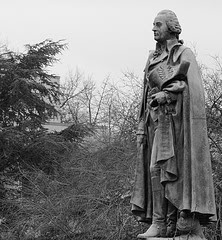
Image: General Artemas Ward Monument
Ward Circle, Washington, DC
The base of the statue bears this inscription:
Artemas Ward, 1727-1800, Son of Massachusetts,
Graduate of Harvard College, Judge and Legislator,
Delegate 1780-1781 to the Continental Congress
Soldier of Three Wars, First Commander of Patriot Forces
Ward Circle is a traffic circle at the intersection of Nebraska Avenue and Massachusetts Avenue in Northwest, Washington, DC. The statue of General Artemas Ward was completed in 1938 without direct pedestrian access to the circle. The land on three sides of Ward Circle is owned by American University, the fourth is home to the headquarters of the Department of Homeland Security.
SOURCES
This Old House
Wikipedia: Artemas Ward
Virtual American Biographies: Artemas Ward
Mass Moments: Revolutionary War Commander Dies
First Commander-in-Chief of the American Revolution
